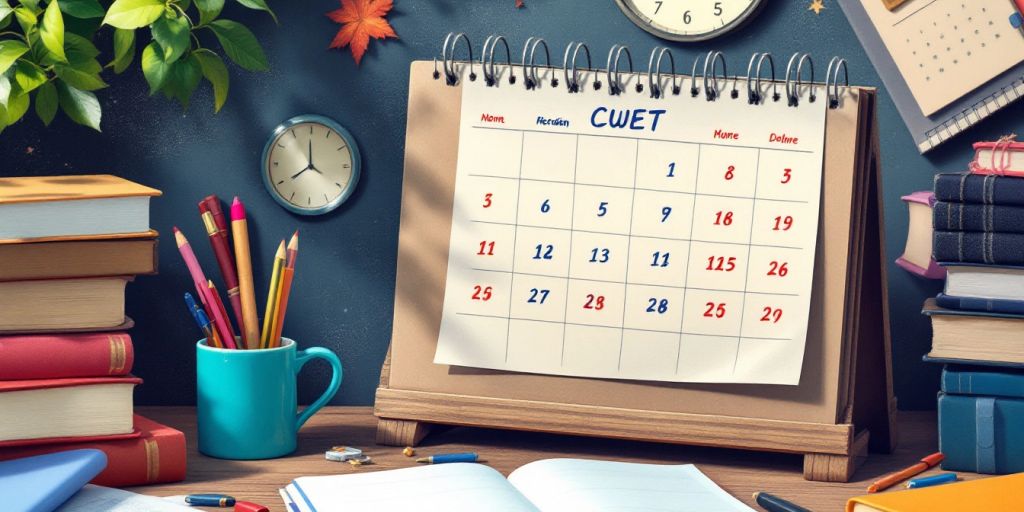Preparing for both the Common University Entrance Test (CUET) and the Common Law Admission Test (CLAT) at the same time can be quite a challenge. However, with the right approach, you can manage your studies effectively. This guide offers insights into how to balance your preparation for these two important exams, ensuring you cover all necessary topics while also taking care of your well-being. Let’s explore the key takeaways that can help you succeed in both exams.
Key Takeaways
- Understand the main topics and formats of both CUET and CLAT.
- Create a study schedule that balances preparation for both exams.
- Use common study materials for overlapping subjects like English and Reasoning.
- Practice with mock tests to get familiar with the exam style and timing.
- Stay organized and take care of your mental and physical health during preparation.
Understanding the Basics of CUET and CLAT

Overview of CUET
The Common University Entrance Test (CUET) is an important exam for students aiming to enter various undergraduate programs in central universities across India. This exam evaluates a wide range of subjects, allowing students to showcase their knowledge and skills in multiple areas. The CUET is designed to assess not just academic knowledge but also critical thinking and problem-solving abilities.
Overview of CLAT
The Common Law Admission Test (CLAT) is specifically tailored for students who wish to pursue law degrees. This exam focuses on assessing candidates’ aptitude in areas such as legal reasoning, logical reasoning, and general knowledge. Success in CLAT can open doors to prestigious law schools and a future in the legal profession.
Key Differences Between CUET and CLAT
While both exams are crucial for students’ academic journeys, they serve different purposes:
| Feature | CUET | CLAT |
|---|---|---|
| Purpose | Admission to various undergraduate programs | Admission to law schools |
| Subjects | Multiple subjects across disciplines | Focused on law-related subjects |
| Exam Format | Varies by subject | Multiple-choice questions |
- CUET covers a broader range of subjects, while CLAT is specialized for law.
- Both exams test critical thinking and comprehension skills, making it beneficial to study overlapping subjects.
- Understanding the unique requirements of each exam is essential for effective preparation.
Preparing for both CUET and CLAT can be a challenging yet rewarding journey. By recognizing the distinct features of each exam, students can tailor their study strategies effectively, ensuring they are well-prepared for their future academic endeavors.
Eligibility Criteria for CUET and CLAT
CUET Eligibility Requirements
To be eligible for the Common University Entrance Test (CUET), candidates must meet the following criteria:
- Educational Qualification: Candidates should have completed their 10+2 or equivalent from a recognized board.
- Minimum Marks: A minimum of 50% marks is generally required, though this may vary by university.
- Age Limit: There is no upper age limit for CUET.
CLAT Eligibility Requirements
For the Common Law Admission Test (CLAT), the eligibility criteria are as follows:
- Educational Qualification: Candidates must have completed their 10+2 or equivalent with at least 45% marks (40% for SC/ST candidates).
- Age Limit: There is no upper age limit for CLAT.
Special Considerations for Both Exams
- Nationality: Only Indian nationals and NRIs can apply for both CUET and CLAT.
- Additional Tests: Some universities may require additional tests or interviews for admission.
| Criteria | CUET | CLAT |
|---|---|---|
| Educational Qualification | 10+2 or equivalent | 10+2 or equivalent |
| Minimum Marks | 50% (varies by university) | 45% (40% for SC/ST) |
| Age Limit | No upper age limit | No upper age limit |
Note: Always check the specific requirements of the universities you are interested in, as they may have unique criteria.
Understanding these eligibility requirements is crucial for aspiring students. Choosing the right coaching institute for CUET and CLAT can significantly enhance your chances of success.
Exam Patterns and Syllabi
CUET Exam Pattern
The Common University Entrance Test (CUET) is designed to assess a wide range of subjects. It includes multiple-choice questions across various disciplines. Here’s a brief overview of the exam pattern:
| Subject Area | Number of Questions | Marks |
|---|---|---|
| General Test | 50 | 200 |
| Subject-Specific Tests | 50 | 200 |
| Total | 100 | 400 |
CUET focuses on a broad range of subjects, making it essential for students to prepare across various topics.
CLAT Exam Pattern
The Common Law Admission Test (CLAT) is specifically tailored for law aspirants. It consists of multiple-choice questions that test various skills. Here’s how the exam is structured:
| Subject Area | Number of Questions | Marks |
|---|---|---|
| English Language | 22-26 | 22-26 |
| Current Affairs | 28-32 | 28-32 |
| Legal Reasoning | 28-32 | 28-32 |
| Logical Reasoning | 22-26 | 22-26 |
| Quantitative Techniques | 10-14 | 10-14 |
| Total | 120 | 120 |
Common Subjects in Both Exams
Both CUET and CLAT share some common subjects, which can be beneficial for students preparing for both. Here are a few:
- English Language: Essential for both exams, focusing on comprehension and grammar.
- Current Affairs: Important for general knowledge and legal awareness in CLAT.
- Logical Reasoning: Critical for problem-solving in both tests.
Preparing for both CUET and CLAT can be a strategic advantage, as overlapping subjects allow for efficient study sessions. By understanding the exam patterns and syllabi, students can create a more effective study plan that caters to both exams’ requirements.
Creating a Balanced Study Schedule

Time Management Tips
Effective time management is crucial when preparing for both CUET and CLAT. Here are some tips to help you manage your time wisely:
- Set clear goals for each study session.
- Break your study time into manageable blocks, focusing on one subject at a time.
- Use a planner to track your progress and adjust your schedule as needed.
Daily and Weekly Study Plans
Creating a structured study plan can help you stay organized. Here’s a simple weekly plan:
| Day | CUET Focus | CLAT Focus |
|---|---|---|
| Monday | Quantitative Skills | Legal Reasoning |
| Tuesday | General Knowledge | Logical Reasoning |
| Wednesday | English Language | Current Affairs |
| Thursday | Revision | Revision |
| Friday | Mock Tests | Mock Tests |
| Saturday | Practice Questions | Practice Questions |
| Sunday | Rest and Review | Rest and Review |
Balancing Common and Unique Subjects
To prepare effectively for both exams, identify subjects that overlap and allocate time accordingly. For instance:
- Common Subjects: English, General Knowledge
- Unique Subjects: Legal Reasoning for CLAT, Quantitative Skills for CUET
Remember, a balanced study schedule not only helps in covering the syllabus but also reduces stress and enhances performance. By integrating study times for both CUET and CLAT, you can maximize your preparation efforts without feeling overwhelmed.
Essential Study Materials and Resources
Choosing the right study materials and resources is crucial for successful exam preparation. Opting for authoritative resources and engaging with online platforms offering practice questions and mock tests can significantly enhance your readiness.
Recommended Books and Guides
- For CLAT: Focus on books that cover legal reasoning, logical reasoning, and current affairs. Some popular titles include:
- Legal Awareness and Legal Reasoning by AP Bhardwaj
- Objective General Knowledge by Manohar Pandey
- For CUET: Look for comprehensive guides that cover the specific subjects you will be tested on, such as:
- NCERT textbooks for foundational knowledge
- Quantitative Aptitude by R.S. Aggarwal
Online Resources and Practice Tests
- Utilize educational apps and websites that provide:
- Mock tests for both CLAT and CUET
- Video lectures on complex topics
- Discussion forums for peer support
Utilizing Past Papers
- Practicing with past exam papers is essential. It helps you:
- Familiarize yourself with the exam format
- Identify common question types
- Improve your time management skills during the exam
Remember, consistent practice and the right resources can make a significant difference in your preparation for both CUET and CLAT.
By integrating these materials into your study plan, you can enhance your chances of success in both exams. For more tips on how to prepare for CLAT on your own, check out resources like CLAT Possible that offer comprehensive guides and strategies.
Effective Study Techniques
Active Learning Strategies
Active learning is crucial for mastering the material for both CUET and CLAT. Here are some effective strategies:
- Engage with the material: Instead of just reading, try summarizing what you learn in your own words.
- Teach others: Explaining concepts to friends or family can reinforce your understanding.
- Use flashcards: Create flashcards for important terms and concepts to enhance memory retention.
Memory Aids and Mnemonics
Using memory aids can help you remember complex information. Here are some tips:
- Create acronyms: Form acronyms from the first letters of a list of items you need to remember.
- Visual imagery: Associate concepts with vivid images to make them more memorable.
- Chunking: Break down large amounts of information into smaller, manageable chunks.
Practice and Revision Techniques
Regular practice is essential for success in both exams. Consider these techniques:
- Daily revision: Set aside time each day to review what you’ve learned.
- Mock tests: Take regular mock tests to simulate exam conditions and improve your time management skills. This is especially important for CLAT and CUET preparation.
- Feedback analysis: After each mock test, analyze your performance to identify areas for improvement. This will help you focus your study efforts effectively.
Remember, consistent practice and revision are key to mastering the content for both CUET and CLAT. Stay organized and keep track of your progress to ensure you are on the right path!
Mock Tests and Performance Analysis
Importance of Mock Tests
Regularly taking mock tests is crucial for getting used to the exam format and timing. Mock tests help you understand the types of questions you will face in both CUET and CLAT. They also allow you to practice under real exam conditions, which can reduce anxiety on the actual test day.
Analyzing Mock Test Results
After completing a mock test, it’s important to analyze your performance. Here are some steps to follow:
- Review your answers: Check which questions you got wrong and understand why.
- Identify weak areas: Focus on subjects or topics where you struggled.
- Adjust your study plan: Use this information to modify your study schedule, ensuring you spend more time on challenging areas.
| Aspect | Description |
|---|---|
| Mock Tests for CUET | Familiarize yourself with the exam layout and question types. |
| Mock Tests for CLAT | Practice legal reasoning and logical reasoning questions. |
| Performance Analysis | Identify strengths and weaknesses to improve your study strategy. |
Tips for Effective Mock Testing
To make the most of your mock tests, consider these tips:
- Simulate exam conditions: Take the test in a quiet place and time yourself.
- Use a variety of resources: Incorporate different mock tests from both CUET and CLAT to cover all bases.
- Stay consistent: Make mock testing a regular part of your study routine.
Regular practice with mock tests not only boosts your confidence but also enhances your performance in both CUET and CLAT.
By following these strategies, you can effectively prepare for both exams and increase your chances of success!
Stress Management and Self-Care
Maintaining Mental Health
Taking care of your mental health is crucial while preparing for exams like CUET and CLAT. Regular breaks can help refresh your mind and improve focus. Here are some tips to maintain your mental well-being:
- Set realistic goals: Break your study material into smaller, manageable tasks.
- Practice mindfulness: Techniques like meditation can help reduce anxiety.
- Stay connected: Talk to friends or family about your feelings and concerns.
Physical Well-being Tips
Physical health plays a significant role in your overall well-being. Engaging in physical activities can boost your mood and energy levels. Consider these activities:
- Exercise regularly: Aim for at least 30 minutes of physical activity each day.
- Eat balanced meals: Nutritious food fuels your brain and body.
- Get enough sleep: Aim for 7-9 hours of sleep each night to recharge.
Balancing Study and Relaxation
Finding a balance between study and relaxation is essential. Here’s how you can manage your time effectively:
- Create a study schedule: Allocate specific times for study and relaxation.
- Incorporate hobbies: Spend time on activities you enjoy to relieve stress.
- Limit screen time: Reduce distractions from social media and other platforms.
Remember, taking care of yourself is just as important as studying for CUET and CLAT. Prioritize your well-being to perform your best on exam day!
Exam Day Strategies
Last-minute Preparation Tips
On the day before the exam, focus on reviewing key concepts rather than cramming new information. Stay calm and confident by revisiting your study notes and practicing a few questions. Make sure to get a good night’s sleep to ensure you are well-rested for the exam.
What to Bring on Exam Day
Prepare a checklist of items to bring on exam day. Here are some essentials:
- Admit card for CUET or CLAT
- Valid photo ID
- Stationery (pens, pencils, erasers)
- Water bottle and snacks (if allowed)
- A watch to manage your time
Managing Exam Day Stress
Feeling nervous is normal, but managing that stress is crucial. Here are some strategies:
- Practice deep breathing to calm your nerves.
- Arrive at the exam center early to avoid last-minute rush.
- Read each question carefully before answering to avoid mistakes.
Remember, both CUET and CLAT are opportunities to showcase your hard work. Stay focused and do your best!
Seeking Guidance and Support
Coaching Centers and Online Courses
Finding the right support can make a big difference in your preparation for both CUET and CLAT. Coaching centers offer structured learning and expert guidance. Here are some popular options:
- Competition Guru: Known for its strategic approach to CUET preparation.
- Pratham Education: Offers personalized mentorship and resources.
- CUET Possible: Focuses on holistic development and tailored learning techniques.
Peer Study Groups
Joining a study group can be incredibly beneficial. Here’s why:
- Moral Support: Sharing the journey with peers can keep you motivated.
- Knowledge Exchange: Discussing topics can deepen your understanding.
- Accountability: Regular meetings can help you stay on track with your study goals.
Mentorship and Counseling
Having a mentor can provide personalized guidance. Look for:
- Experienced Teachers: They can offer insights into exam strategies.
- Counselors: They can help manage stress and maintain a balanced approach to studying.
Remember, seeking help is a sign of strength. Utilize available resources to enhance your preparation for both CUET and CLAT. This comprehensive guide offers essential tips and strategies for preparing for the CLAT 2025 exam, emphasizing a disciplined approach to ensure success.
Post-Exam Plans and Next Steps
Interpreting Your Scores
After taking the CUET and CLAT exams, the first step is to carefully analyze your scores. Understanding your performance can help you identify strengths and weaknesses. Here’s how to interpret your results:
- Compare your scores with previous years’ cut-offs for your desired universities.
- Identify areas for improvement based on your performance in different sections.
- Seek feedback from teachers or mentors to gain insights into your results.
Applying to Universities
Once you have your scores, it’s time to apply to universities. Here are some steps to follow:
- Research universities that accept CUET and CLAT scores.
- Prepare your application materials, including personal statements and recommendation letters.
- Submit your applications before the deadlines to ensure you don’t miss out on opportunities.
Planning for Future Studies
Regardless of your exam results, it’s essential to plan your next steps:
- Consider alternative courses if your scores don’t meet your expectations.
- Explore internships or volunteer opportunities to gain experience in your field of interest.
- Stay updated on any changes in admission processes for future exams.
Remember, your journey doesn’t end with the exams. Stay proactive in pursuing your academic and career goals, whether through further studies or practical experiences.
Summary Table of Next Steps
| Step | Action Item |
|---|---|
| Interpreting Scores | Analyze and compare with cut-offs |
| Applying to Universities | Research, prepare, and submit applications |
| Future Studies Planning | Consider alternatives and gain experience |
After your exams, it’s time to think about what comes next. Whether you’re planning to dive into law studies or explore other options, we’re here to help you every step of the way. Visit our website to discover courses and resources that can guide you toward your future goals. Don’t wait—take action now!
Conclusion
In summary, preparing for both the CUET and CLAT exams at the same time can be a smart move if done right. By following the advice in this guide, you can make your study time more effective and boost your chances of doing well. Here are some important points to remember:
- Make a detailed study plan that includes all the topics you need for both tests.
- Use your time wisely, ensuring you spend enough hours on each subject.
- Practice with past exam papers to get used to the types of questions you will face.
- Get help from teachers or join classes for expert advice.
- Stay focused and keep your motivation high while balancing your studies.
- Take regular breaks, exercise, and get enough rest to stay productive.
By using these strategies, you can confidently prepare for both the CUET and CLAT exams, setting yourself up for success. Good luck!
Frequently Asked Questions
How can I prepare for CUET and CLAT at the same time?
To study for both CUET and CLAT together, first understand their syllabi. Create a balanced study schedule that gives time to both exams. Use common study materials and practice regularly with mock tests.
Should I focus more on CUET or CLAT?
It depends on your goals. If you want to study law, focus more on CLAT. If you’re looking at various undergraduate programs, give equal attention to CUET.
Which colleges accept CUET scores for law programs?
Some central universities accept CUET scores for law programs. You should check the specific universities for their admission criteria.
Are there any universities that do not accept CUET scores for law?
Yes, some universities do not accept CUET scores for law. It’s important to verify which ones do and do not accept these scores.
What is the CUET syllabus for law programs?
The CUET syllabus for law includes subjects like English, General Knowledge, and Current Affairs. Check the latest syllabus for updates.
Has the CLAT syllabus changed this year?
Yes, the CLAT syllabus can change. Always check the official website for the most current information.
What are some effective study techniques for both exams?
Use active learning strategies, make flashcards, and take regular mock tests to improve your preparation for both CUET and CLAT.
How can I manage stress while preparing for these exams?
To manage stress, take regular breaks, engage in physical activities, and ensure you get enough sleep. Balancing study and relaxation is key.

































